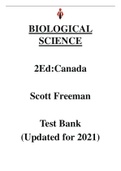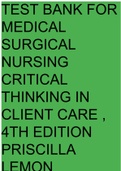Exam (elaborations)
BIOLOGICAL SCIENCE 2Ed Canada Scott Freeman Test Bank-(Updated for 2021)
- Course
- BIOLOGY
- Institution
- Arizona State University
Infused with the spirit of inquiry, Freeman's Biological Science helps teach readers the fundamentals while introducing them to the excitement that drives the science. By presenting unifying concepts and methods of analysis, this book helps its readers learn to think like biologists and gives them ...
[Show more]




